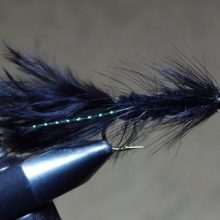This article may contain affiliate links. If you make a purchase after clicking on a link we may earn a small commission at no extra cost to you. As an Amazon Associate, I earn from qualifying purchases.
Marabou Jigs for Trout – Tips and Tricks

Fishing with marabou jigs for trout has to be one of the best ways to land a trophy fish.
Unfortunately it is not a method that is used a lot these days.
Modern fishermen prefer to use newer flashier jigs for trout that cost a fortune and only get mediocre results.
Marabou jigs are cheap, easy to fish and responsible for some very large trout being caught.
They are also quite versatile on both rivers and streams and small lakes.
What is a Marabou Jig?
A Marabou jig is a small jig that has a dyed Marabou(turkey feathers) tail. The body of the jig can have a chenille body and a dressed hackle.
More often than not there is no dressing on the body and the tail or streamer of Marabou starts at the head.
The head of the jig is usually weighed by a small metal bead. The beads can be painted a different color to the tail for added contrast.
The Marabou jig is meant to imitate small aquatic insects that are found naturally in small rivers and lakes.
Twitching the rod tip as they move through the water is what is meant to imitate the insects natural erratic movements.
Types of Marabou Jigs
A lot of commercially available Marabou jigs are aimed at crappie fishing and not at trout. These types of jigs tend to have very flashy unnatural colors.
Try to stay away from these types of patterns. For trout it is usually the most natural colors that work best.
Black, brown, olive and white have been the best performers.
There are a lot of different body designs and materials to choose from. The tried and tested Wholly Bugger patern is always a winner. It is pretty simple and
Marabou Jigs for Trout
Trout fishing with Marabou jigs requires that you work the jig in such a way that it has a bit of life in it.
Unlike other trout lures a jig is effectively lifeless until you add a big of action into it. It is then that the Marabou tail can come to life.
This action is normally by way of twitching the rod tip as it either falls or as you retrieve it a little.
Your retrieve should be staggered, so use a start stop type of retrieval. Basically you want the jig to rise up as you retrieve it then pause momentarily so that it falls through the water.
More often than not the trout will actually strike the jig as it falls.
On smaller waters you can cast upwards of where you think the trout might be lying. Continue with this stop/start retrieval so that the jig moves just slightly faster than the current.
Remember to add in some random yet light twitches through the rod tip.
On larger rivers you can cast out in a fan like pattern to cover the most water. With the deeper water it can be a good idea to allow the jig to sink and then twitch it along the bottom, retrieving any slack as the jig moves towards you.
Never allow any slack in the line as you need to keep in constant contact with the end of your line.
Tackle to Use with a Marabou Jig
Like most trout fishing setups that are used in smaller waters like mountain streams and small rivers the correct tackle for a fishing a marabou jig will be an ultralight spinning rod and reel.
However, for getting the best out of these small jigs you would ideally be on the lightest tackle possible.
The best spinning rod for trout when using small jigs is an ultralight rod that has a very light line rating.
Rod – Roughly 6 foot, with a fast action and a light/ultralight rating. You need the fast action for better and more sensitive tip control.
Reel – A standard spinning reel for trout on light gear would be either a 1000 if you are using 2 lb line or up to a size 2500 if using heavier line.
Line – Ideally you will want to be using 4 lb mono as your main go to. Only on much larger and faster moving rivers would you want to use 6 lb line. That being said 2 lb line is quite popular when using small jigs especially on really clear streams.
Just be aware that when you do drop down as light as 2 lb you need to routinely check the line for any cuts or abrasions as it can get damaged very easily on rough rocks on the river bottom.
